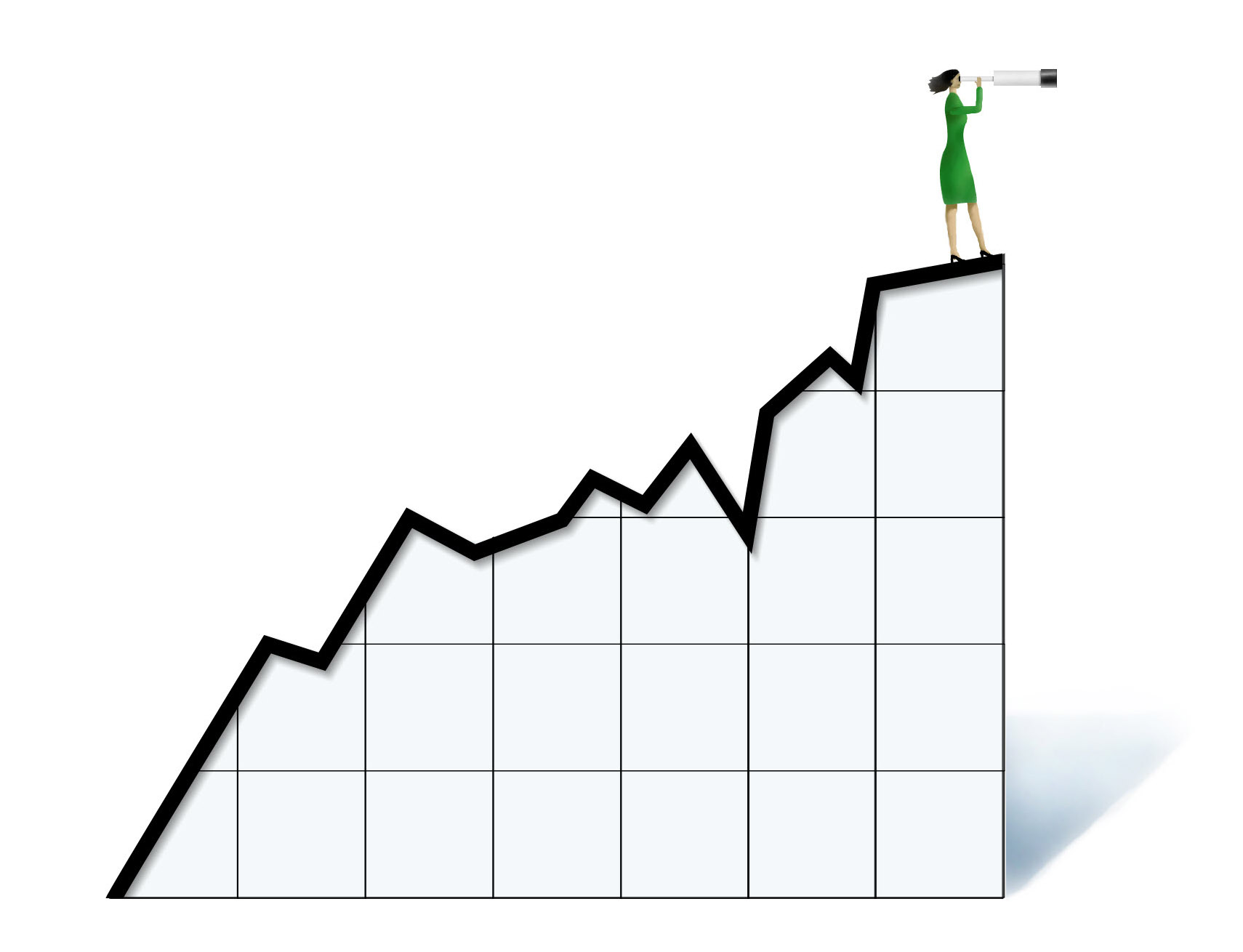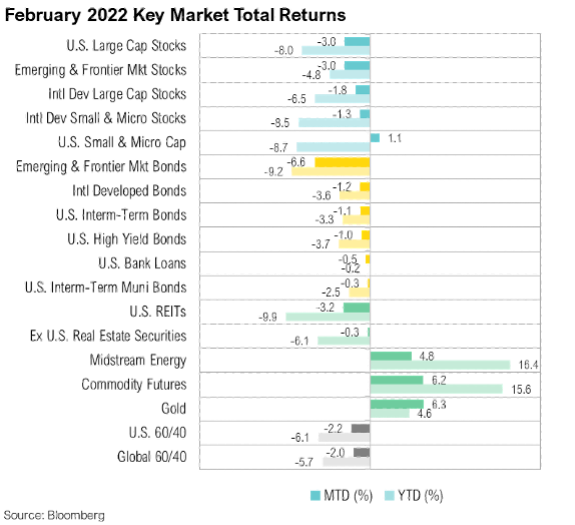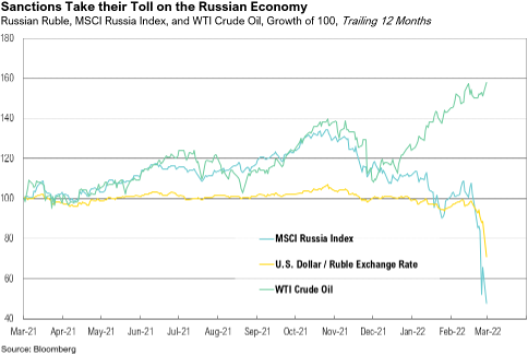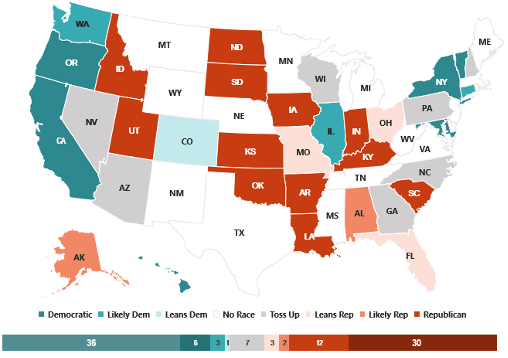Overview
Just before dawn on February 24, 2022, explosions rang out across major Ukrainian cities, as Russia invaded its neighbor to the west. The move, according to policy experts at The Brookings Institution, represents an attempt by Vladimir Putin to stop NATO’s eastward creep and restore the map of Europe—and Russia’s role on the continent—to its pre-NATO glory.1 In the days following the invasion, most Western countries responded with support, ranging from military equipment to economic sanctions.2,3 February’s market tape bore some scratches but few scars from the conflict, as losses were stemmed by a late-month rally in stocks. Global balanced portfolios, proxied by a blend of 60% global stocks and 40% global bonds, declined just 2%. Crude oil ended the month at almost $96/barrel, up $8 for the month. Gold rallied to $1,911/ounce on its perceived role as a safe haven, and the U.S. 10-year Treasury Note yield rose 6 basis points to close at 1.84%.
Russian Invasion
This recent escalation by Putin in an almost decade-long conflict began last November, when Russia started amassing tens of thousands of troops in four different locations near the Ukrainian border in response to Ukraine’s request to be added to NATO.4 Russia stepped up its efforts in January, deploying troops into Belarus, which borders Ukraine to the north, under the guise of “military exercises.” NATO responded by sending 3,000 troops, along with ships and fighter jets, to bolster Eastern European defenses.4 Just two days before the invasion, Russia formally recognized the independence of Donetsk and Lugansk, two separatist regions in eastern Ukraine, and ordered Russian troops into the regions on a “peacekeeping” mission.4
Russia initially targeted major government and military locations and airfields before moving onto Ukrainian infrastructure, such as commercial airports.5 However, civilian buildings were soon hit by bombings as well, and as of the end of February, the U.N. reported at least 536 Ukrainian civilian casualties.6 The fighting prompted a mass civilian migration, as more than two million Ukrainians have already fled to Western Europe for safety. The E.U. estimates that up to seven million people may try to leave the country because of the invasion.7
Having sold off in the weeks leading up the invasion, global equity markets initially declined on the morning of the 24th, but then staged one of the more impressive intraday reversals in history, closing the day in positive territory. From its intraday low of 4,115, the S&P 500 Index rallied 6.3% in the last three days of February, reducing the monthly decline to just 3.0%. The Wall Street adage of “buy on the cannons, sell on the trumpets”—a cliché that’s rung true since at least the Napoleonic wars—confounded headline writers yet again.8
Western powers responded with a range of sanctions, which increasingly intensified. But if Ukrainians’ heroic response, led by the inspiring Volodymyr Zelenskyy, set the bar, Europe initially fell short, limited by the practicalities of a conflict between deeply entrenched trading partners. Germany, for instance, needed to preserve its ability to buy Russian natural gas, which supplies about 55% of its domestic demand.9 The Italians felt compelled to carve out luxury goods from export sanctions, as did the Belgians with diamonds, so that Russian oligarchs’ spending power would not be diminished.10 Western media was quick to pick up the “Gucci loafer” exemption, generating enough public pressure to cause Italy to pivot.10,11 Similar choices were made across all of Western Europe, as the continent struggled with the impossible task of stopping trade with a country that provides as much as 40% of its natural gas.12 In the ensuing days, the intensity of the fighting increased, both in the cities and towns of Ukraine, as well as across the global capital markets.
Despite the costs of sanctions to both sides, western powers gradually introduced more punitive measures to cut the Russian economy and financial system off from the rest of the world. Among the most severe was the removal of some Russian banks from SWIFT, a secure messaging system used for trillions of dollars’ worth of transactions around the world, essentially barring them from international transactions.13 This resulted in Russian citizens lining up at ATMs out of fears of cash shortages.14 Restrictions were also imposed on Russia’s central bank, attempting to prevent it from using its $643 billion of international reserves and ultimately freezing the assets of the bank completely. The E.U. also announced a total closure of E.U. airspace to all Russian aircraft, banned Kremlin-funded news sources from European airwaves, and extended new sanctions against Belarus, which has aided Russia in the invasion.13,14 The E.U. also agreed to finance the purchase and delivery of weapons to Ukraine, marking the first time it has ever financed such measures in its history.15 The private sector also stepped in: British Petroleum (BP), the biggest foreign investor in Russia, abandoned its $25 billion stake in the state oil company Rosneft; Alphabet’s Google and Meta’s Facebook barred Russian media outlets from receiving money from ads on their websites, apps, and YouTube videos; and UPS and FedEx halted their delivery service to both Russia and Ukraine.16 In addition, MSCI, the sponsor of the widely used MSCI suite of global stock benchmarks, said that delisting Russia was “the next logical step.”17 These severe sanctions have sent both Russian stocks and the Russian ruble plummeting, down 67% and 33% year-to-date, respectively.
Russia responded by closing its stock market to prevent further investor outflows and hiking its policy interest rate from 9.5% to 20% to encourage savers to leave ruble deposits in the banking system.18 The downside to this approach will be an inevitable slowing of the Russian economy, beyond what would have already occurred due to declining exports.
Although these sanctions will be devastating to the Russian economy and the conflict devastating to Ukraine’s, the benign initial reaction from global capital markets is likely based on the hope that the spillover to the rest of the global economy will be muted. From a purely economic perspective, there are at least a few reasons for this hope. First, these economies account for a small share of total global trade, with Russia accounting for 1.6% and Ukraine 0.3%.19 Second, more than half of Russia’s exports are fuel products, which have so far been excluded from most sanctions. But, that has started to change and there are increased concerns of world trade becoming significantly more dislocated. President Biden announced on March 8th that the United States would ban imports of Russian oil. Oil prices spiked to their highest levels since 2008 on the news. Outside the U.S., the U.K announced they would phase out Russian oil by the end of 2022 and the European Union said it was planning to reduce usage of Russian oil by two-thirds by the end of 2022.20 Finally, the Black Sea is not a major global trading line, so there is less scope for third-party trade to be disrupted.
A final reason for potential hope emerged on the last day of the month, as Russian and Ukrainian forces agreed to meet in Belarus. While the negotiations produced no tangible results, the two sides agreed to meet a second and third time in early March to continue discussions.21,22
U.S. Midterm Elections
With the first primary election kicking off on March 1 in Texas, investors are beginning to look ahead to November’s midterms. For background, the Senate is currently split 50-50, with Vice President Kamala Harris serving as the tiebreaker, and Democrats control the House by four seats. There are 34 Senate seats up for reelection, 20
Republicans and 14 Democrats. To flip the Senate, Republicans will need to win at least 21 of the 34. According to Real Clear Politics, 17 seats lean Republican, 10 lean Democrat, and 7 are toss-ups as of the end of February.23 Based on these polls, Republicans will need to win four of the remaining seven toss-up elections to gain control of the Senate. The popular betting website PredictIt has the implied probability of a Republican takeover of the Senate at 76%.24 For the House, the probability of a Republican takeover has climbed to 83%.25
Many factors complicate the political landscape this year. First, voters are frustrated, and they may wish to express that frustration in November. President Biden’s approval rating has declined steadily since last summer, and it was sitting at a 41% at the end of the month, tying Donald Trump for the worst approval rating in history 408 days into a first term.26 The February release of the University of Michigan Consumer Confidence Survey provided some insight into this growing resentment. According to the Survey’s chief economist, Richard Curtin:
“[consumer sentiment] remained at its lowest level in the past decade. The February descent resulted from inflationary declines in personal finances, a near-universal awareness of rising interest rates, falling confidence in the government's economic policies, and the most negative long-term prospects for the economy in the past decade.”27
With a potentially protracted conflict in Ukraine, the Biden Administration may not get a reprieve in the form of lower energy prices any time soon. Even without these issues, Democrats will have to contend with the historical tendency for the political pendulum to swing away from the party in control of the White House. According to data going back to 1862, the President’s party loses 33 House seats and two-and-a-half Senate seats, on average.28 In fact, there have only been three instances where the President’s party gained seats in both bodies of Congress during midterms: 1902, under Theodore Roosevelt; 1934, under Franklin D. Roosevelt; and 2002, under George W. Bush. Another likely contributing factor in this trend is that the stock market generally does not perform well during midterm years, averaging just 1% since 1966, compared to 10.7% in non-midterm years.
Another complicating factor is the dramatic migration that has occurred both into and out of the seven states currently viewed as toss-ups. Of these, Nevada, Arizona, and North Carolina were in the top ten states for inbound migration, while Pennsylvania was in the top ten for outbound migration.29 On aggregate, voters appear to be leaving high-tax, high-cost states for lower-tax, lower-cost alternatives. In the top one-third of states for population growth since the start of the pandemic, the average combined top marginal state and local income tax rate is 3.5%, while in the bottom third of states, it is 7.3%.29
Looking Forward
The crisis in Ukraine has exacerbated a risk factor that was already impacting markets—rising inflation—and it has complicated, though not changed, the likely policy response to it—tighter monetary policy. The Russian invasion of Ukraine will drive prices even higher, particularly in non-discretionary areas like food and energy. These are areas that hurt consumers the most, even if they are not directly included in some of the Fed’s preferred inflation measures. This could put even more pressure on the Fed to make fighting inflation its highest priority. The longer the Russian campaign continues, the more damage will be done to global supply chains, the higher commodity prices will go, and the more frustrated voters will become. In a midterm year, the voice of voters carries more weight than normal. In that vein, we refer back to University of Michigan Consumer Confidence survey chief economist, Richard Curtin:
“The most likely linkage [of the conflict in Ukraine] to the domestic economy is through rising energy prices, with the size and length of the potential increases subject to substantial uncertainty. This will complicate the Fed's policy actions, tilting their objectives to focus more on inflation at the cost of slower growth and higher unemployment. The financial harm and growing angst among consumers about rising inflation have pushed nearly nine-in-ten consumers to anticipate interest rate hikes. The Fed's clinging to the transient hypothesis meant missed opportunities to nip inflation at its earliest stages; aggressive actions are now needed to avoid the potential establishment of an inflationary psychology that acts to form a self-fulfilling prophecy.”27
We hope the situation in Ukraine will be resolved quickly, that Ukraine’s sovereignty will be preserved, and that inflationary pressures will wane in the coming months, reducing pressure on the U.S. consumer and supporting markets. Despite that hope, we expect that volatility in the coming weeks and months will remain elevated. At RMB, we continue to advocate that investors remain diversified and utilize investment allocations that have the potential to perform well in a broad range of market outcomes. In an environment like this, we recommended sticking to long-term asset allocation targets, while focusing on high-quality core investments that have the ability to weather through volatile interest rates and higher levels of inflation. Our team continues to focus on balancing opportunities in the current environment and taking advantage of opportunities that present attractive risk/reward profiles, while remaining cognizant of the ever-changing market dynamics.
Citations
- Brookings: https://www.brookings.edu/blog/order-from-chaos/2022/02/25/around-the-halls-implications-of-russias-invasion-of-ukraine/
- Washington Post: https://www.washingtonpost.com/world/2022/03/02/boycotts-russia-invasion-ukraine/
- Economist: https://www.economist.com/the-economist-explains/2022/03/02/how-western-governments-are-getting-military-gear-into-ukraine
- Reuters: https://www.reuters.com/world/europe/events-leading-up-russias-invasion-ukraine-2022-02-28/
- AP: https://apnews.com/article/russia-ukraine-putin-attack-a05e7c4563ac94b963134bba83187d46
- Reuters: https://www.reuters.com/world/un-reports-least-536-civilian-casualties-ukraine-2022-03-01/
- BBC: https://www.bbc.com/news/world-60555472
- Stock Investor: https://www.stockinvestor.com/7733/buy-on-the-cannons-sell-on-the-trumpets/
- teleSUR: https://www.telesurenglish.net/news/Germany-Cant-Stop-Importing-Russian-Energy-Habeck-20220303-0008.html
- Daily Caller: https://dailycaller.com/2022/02/25/report-italy-scored-gucci-loafers-carve-out-in-russian-sanctions/
- Oumiss: https://oumiss.com/luxury-goods-crypto-may-be-impacted-by-new-rounds-of-russian-sanctions.html
- NPR: https://www.npr.org/2022/02/09/1079338002/russia-ukraine-europe-gas-nordstream2-energy
- NY Times: https://www.nytimes.com/article/russia-us-ukraine-sanctions.html
- NY Times: https://www.nytimes.com/2022/02/28/world/europe/russia-economy-sanctions-ukraine.html
- Politico: https://www.politico.eu/article/eu-ukraine-russia-funding-weapons-budget-military-aid/
- Reuters: https://www.reuters.com/business/bp-exit-opens-new-front-wests-campaign-against-russia-2022-02-27/
- Reuters: https://www.reuters.com/business/exclusive-msci-says-removing-russia-indexes-natural-next-step-2022-02-28/
- CNBC: https://www.cnbc.com/2022/02/28/russia-central-bank-hikes-interest-rates-to-20percent-from-9point5percent-to-bolster-ruble.html
- Capital Economics: https://research.cdn-1.capitaleconomics.com/fabaa4/russia-ukraine-war-risks-renewed-trade-disruptions.pdf?utm_source=Sailthru&utm_medium=email&utm_campaign=Global%20Trade%20Monitor%20010322&utm_term=ce_publication
- https://www.barrons.com/articles/russia-oil-imports-ban-crude-prices-51646667317?mod=hp_LEAD_1?mod=article_signInButton
- NBC News: https://www.nbcnews.com/news/world/ukraine-president-kyiv-kharkiv-foreign-fighters-join-russia-putin-rcna17844
- CNN: https://www.cnn.com/europe/live-news/ukraine-russia-putin-news-03-02-22/h_1a61593f0577c696496aa348f6004cd2
- Real Clear Politics: https://www.realclearpolitics.com/epolls/2022/senate/elections-map.html
- PredictIt: https://www.predictit.org/markets/detail/6874/Which-party-will-control-the-Senate-after-2022-election
- PredictIt: https://www.predictit.org/markets/detail/6892/Which-party-will-win-the-House-in-the-2022-election
- FiveThirtyEight: https://projects.fivethirtyeight.com/biden-approval-rating/
- UofM: http://www.sca.isr.umich.edu/
- Brookings: https://www.brookings.edu/wp-content/uploads/2017/01/vitalstats_ch2_tbl4.pdf
- Tax Foundation: https://taxfoundation.org/state-population-change-2021/
All market pricing and performance data from Bloomberg, unless otherwise cited. Asset class and sector performance are gross of fees unless otherwise indicated.
The opinions and analyses expressed in this newsletter are based on RMB Capital Management, LLC’s (“RMB Capital”) research and professional experience are expressed as of the date of our mailing of this newsletter. Certain information expressed represents an assessment at a specific point in time and is not intended to be a forecast or guarantee of future results, nor is it intended to speak to any future time periods. RMB Capital makes no warranty or representation, express or implied, nor does RMB Capital accept any liability, with respect to the information and data set forth herein, and RMB Capital specifically disclaims any duty to update any of the information and data contained in this newsletter. The information and data in this newsletter does not constitute legal, tax, accounting, investment or other professional advice. Returns are presented net of fees. An investment cannot be made directly in an index. The index data assumes reinvestment of all income and does not bear fees, taxes, or transaction costs. The investment strategy and types of securities held by the comparison index may be substantially different from the investment strategy and types of securities held by your account. The S&P 500 Index is widely regarded as the best single gauge of the U.S equity market. It includes 500 leading companies in leading industries of the U.S economy. The S&P 500 focuses on the large cap segment of the market and covers 75% of U.S. equities. The Bloomberg Barclays U.S. Aggregate Bond Index is a broad based benchmark that measures the investment grade. The Consumer Price Index (CPI) is a measure of the average change over time in the prices paid by urban consumers for a market basket of consumer goods and services. Indexes are available for the U.S. and various geographic areas. Average price data for select utility, automotive fuel, and food items are also available. The MSCI All Country World Index (ACWI) is a stock index designed to track broad global equity-market performance. Maintained by Morgan Stanley Capital International (MSCI), the index comprises the stocks of nearly 3,000 companies from 23 developed countries and 25 emerging markets.










